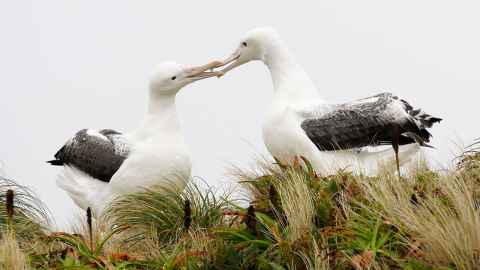Saving the mighty albatross
24 June 2021
Opinion: It's not too late to turn around the decline of our albatross populations, despite the multiple threats they face today. Ariel-Micaiah Heswall looks at how.

Albatrosses are an amazing group of animals. They spend an incredible 84 percent of their lives soaring across the ocean, foraging and migrating thousands of kilometres. These migratory journeys often take them over to South America, Australia and the sub-Antarctic. Out of the 24 species of Albatrosses around the world, 13 species breed within New Zealand waters. They are adored by many people in New Zealand and highly prized as a unique treasure. Books have been written about them and they are mentioned in many cultural myths and legends.
World Albatross Day was celebrated around the globe last Saturday, which makes this a good time to talk about these unique and magnificent seabirds, about the risks they face and what is being done to ensure their conservation.
Firstly, some facts. Albatross can live for many years. The Laysan Albatross has a lifespan of more than 50 years and the Southern Royal Albatross can live past 42 years. Albatrosses can lay one egg once a year, or once every two years, and they often mate for life, forming strong bonds with the same partner. Each albatross species has its own unique courtship rituals which they perform to their mate. These can involve ritualised head movements, dance, preenings and ‘sexy’ vocals. They have an enormous wingspan of approximately 3m and their weight can vary from 2-7kgs. For example, the Atlantic Yellow-nosed Albatross weighs 2.1kg while the wandering albatross weighs in at a whopping 7kg.
Unfortunately, these long lived, low fecund birds are at risk from a plethora of threats. These threats include climate change, plastic ingestion, invasive pests and bycatch risk from commercial fishing. Bycatch is the unintentional catch of an animal in fishing gear which is not the intended target of the fishery. It leads to hundreds of thousands of seabird deaths around the world each year and bycatch incidents of albatrosses are some of the highest.
A study of the risk of commercial fisheries to New Zealand seabird populations in 2013 by Richard and Abraham for the Ministry of Primary Industries, in the summary of the capture of seabirds in New Zealand commercial fisheries, 2002–03 to 2013–14, showed 476 Salvin’s Albatross, 394 white-capped albatross, over hundreds of Southern Buller’s Albatross and nearly 150 Northern Buller’s Albatross were caught as bycatch in New Zealand waters.
These numbers are alarming. Since albatrosses migrate thousands of kilometres, there is a higher chance of multiple interactions with fishing vessels along their migratory routes especially if the fishery is competing with the same food resource. And increasing the chance of albatross-fishery interaction inevitably results in an increased likelihood of bycatch.
Luckily, research is being done into methods to mitigate bycatch risk. These include dying the bait blue to reduce conspicuousness and using tori lines/streamers to scare the seabirds away from the gear. These mitigation methods often incorporate techniques developed through sensory ecology (the study of how an organism interacts with the environment from a sensory perspective). The potential sensory ecology offers to increasing our understanding of why seabirds are attracted to the fisheries, and then caught, is huge.
A recent study has used sensory ecology to look into whether certain morphological (the size and shape of the birds) and sensory traits (i.e. noses, eyes and ears) correlate with bycatch and yes, they do. Generally, seabirds with larger bodies and wings are more likely to become bycatch. This presents a huge threat for the albatrosses which have much larger bodies and wingspans compared to the other seabirds. Furthermore, those seabirds with greater sensory capabilities are more likely to become bycatch as they are more likely to detect the bait and offal discharges, therefore leading to greater fishery interaction. Albatrosses have some of the highest ganglion cell densities in the eye and therefore could have a strong capability to visually detect the bait and chum which therefore increases their bycatch risk.
Over the years, the growth in human population and the habits we have developed have led to more plastic pollution ending up in the oceans and on our coastlines, often ingested by marine organisms including albatrosses. Plastic ingestion is another common threat for seabirds as the plastic can be similar in odour and appearance to the seabird’s prey items. Albatrosses have even been recorded feeding plastics to their chicks. Sometimes, if lucky, they will regurgitate the plastic which is what had happened with an albatross chick at Taiaroa Head, Otago Peninsula, when a small toy pony was discovered in its nest. However, some of the plastic ends up remaining in the gut of the albatross where is can cause punctures and eventually death from starvation.
However, on a more positive note, all is not lost for these seabirds. The Department of Conservation in New Zealand and similar conservation organisations worldwide are acknowledging the threats facing albatrosses and other seabirds and are actively attempting to reduce these threats.
Awareness days such as World Albatross Day help share knowledge about these amazing birds and the research going in to understand their behaviour and reduce any potential harm on them. With more research, public engagement and support, the future for the albatross is looking hopeful and bright.
Ariel-Micaiah Heswall is a doctoral candidate studying seabird sensory ecology in the School of Biological Sciences.
This article reflects the opinion of the author and not necessarily the views of the University of Auckland.
Used with permission from Newsroom Saving the Mighty Albatross 24 June 2021.
Media queries
Alison Sims | Research Communications Editor
DDI 09 923 4953
Mob 021 249 0089
Email alison.sims@auckland.ac.nz